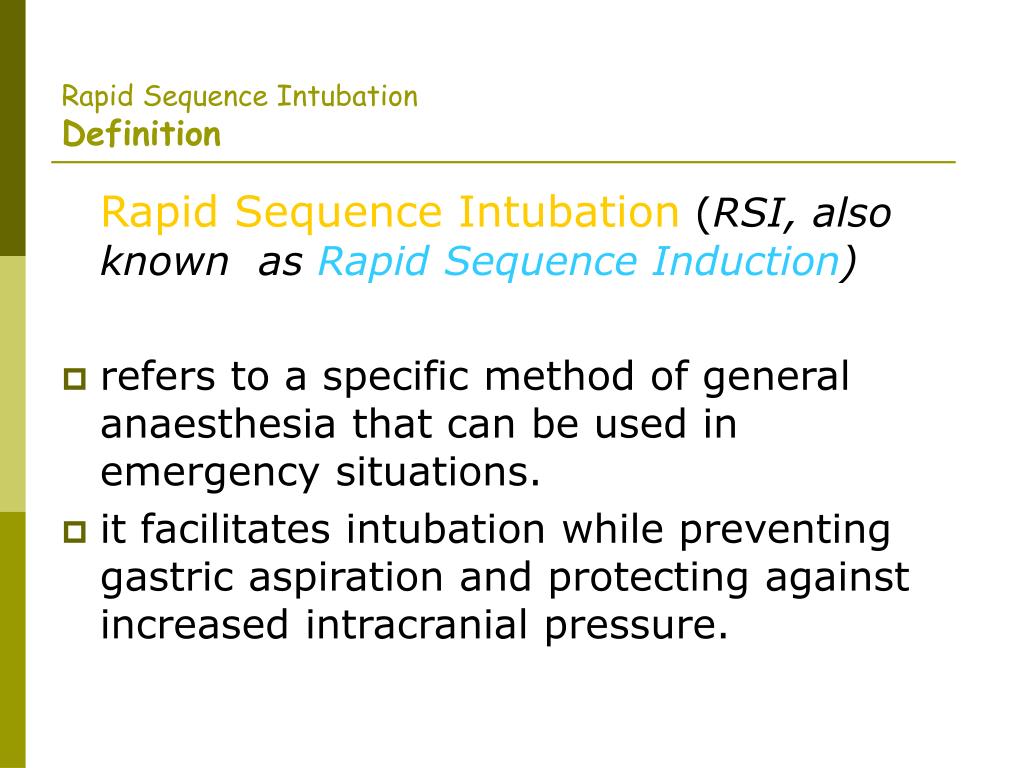
Historically, a ‘classical’ RSI has employed thiopental as an induction agent and succinylcholine for neuromuscular block. By 1956, there were a further 110 deaths attributable to aspiration of gastric contents. In 1950, the Association of Anaesthetists of Great Britain investigated deaths associated with anaesthesia and found 43 deaths caused by regurgitation and aspiration. Pulmonary aspiration of gastric contents has long been recognized as a risk during anaesthesia. There are alternative non-depolarizing neuromuscular blocking agents available with rapid onset times which provide an alternative to succinylcholine. It may often be appropriate to use an opioid during rapid sequence induction of anaesthesia. induction using a predetermined induction dose, cricoid pressure and insertion of a tracheal tube prior to mechanical ventilation of the lungs. The essential features of RSI are preoxygenation, i.v.

This is of paramount importance to us as providers and to our community as a whole.Rapid sequence induction (RSI) is performed to prevent aspiration of gastric contents in patients who are inadequately starved, have impaired gastric emptying or are known to have a history of gastric reflux. Overall, implementation of quality and performance improvement strategies can mitigate the occurrence of adverse events and lead to improved health outcomes for our patients. Continuous evaluation of FPS and the incidence of RSI-related complications will allow for assessment of not only our quality improvement initiative, but of our educational methodology as well. Furthermore, our clinical skills training process involves an integrative approach, pioneered by our interdisciplinary team of educators. Integration of a checklist in the RSI procedure will help to increase FPS rates and act as a method to aid in continuous evaluation and improvement of overall airway performance.Īlthough many airway performance improvement studies exist, our institution is unique in that we are a new Emergency Medicine (EM) Residency program that will be comprised of only post-graduate year 1 (PGY1) and post-graduate year 2 (PGY2) EM residents at the commencement of data collection.

The introduction of checklists as a process improvement tool has been identified as a successful strategy for improving the effectiveness and quality of procedures throughout healthcare. To maximize FPS and increase the safety of the procedure, it is essential to develop a tool to maximize efficacy. Thus, establishing effective methods of decreasing the occurrence of failed attempts will result in an immediate reduction of unintended issues. The number of failed intubation attempts (3+) has been directly correlated with the an increased development of complications. According to the 4th National Audit Project of the Royal College of Anesthetists, it was determined that 30% of patients in the ED and 60% of patients in the ICU experiencing an airway related incident, suffered brain damage or death. These complications commonly lead to poor or life-threatening outcomes and include desaturation, hypotension, dysrhythmia, cardiac arrest, pneumothorax, dental trauma, and esophageal intubation. Unfortunately, many complications can arise during RSI, the incidence of which has remained high.

According to a variety of studies published over the last decade, including a large, multi-center systematic review and meta-analysis, the mean FPS rate (84%) has been used as an institutional benchmark for ED airway proficiency.

First-pass success (FPS) in Rapid Sequence Intubation (RSI) is the most commonly utilized metric for evaluation and allows for comparison across clinical environments.


 0 kommentar(er)
0 kommentar(er)
